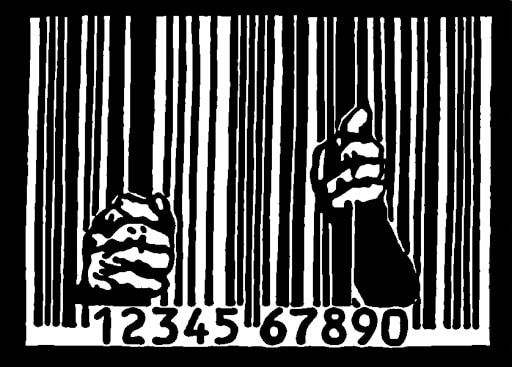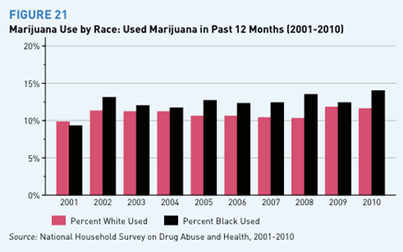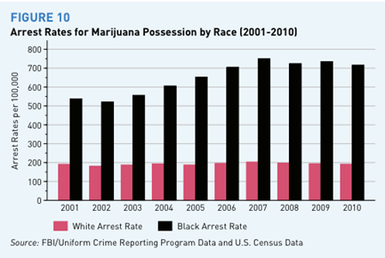|
The United States has by far the highest incarceration rate in the world- 707 per 100,000 in 2012 (Coates). This is even more than Russia led by America’s favorite boogeyman, Vladimir Putin, which incarcerates its population at a rate of 463 per 100,000 (Statista). And Russia is the only other industrialized nation that comes close, with the median among all nations being 125 per 100,000 (Liptak). In absolute terms, the United States incarcerates 2.2 million people, 600,000 more than China despite having one-fourth of China’s total population (Coates). Currently, the United States makes up less than 5 percent of the total world population but about 25 percent of the total prison population. The group most severely impacted by this ubiquitous system of punitive justice has been by far the black population, specifically black males. Although black Americans make up 12% of the total population, they represent a large majority of those imprisoned. In 2000, one in 10 African American men between the ages of 20 and 40 were incarcerated- a rate 10 times higher than their white counterparts (Coates). Further despite evidence that blacks and whites use illicit drugs at nearly identical rates, imprisonment for African-American drug offenders consistently dwarfs the rate for whites. A study published in 2000 by the National Institute on Drug Abuse concluded that white students use cocaine at seven times the rate of black students, crack cocaine at 8 times the rate of black students, and heroin also at 7 times the rate of black students (vol. 1). Another study published in 2000 found that white youth aged 12-17 are more than one-third more likely to have sold drugs than corresponding black youths (U.S. Department of Health). Revealingly, the calls for law and order, which would precipitate mass incarceration, came directly after the Civil Rights Act of 1964. Indeed, claims that the social fabric of American society was melting away, leading to violence and lawlessness, largely began as a reaction to the Civil Rights movement. Many conservative politicians blamed civil rights leaders for their doctrine of “direct action” and civil disobedience, claiming their tactics were nothing short of criminal. The then former Vice President Richard Nixon echoed this notion stating, “The deterioration of respect for the rule of law can be traced directly to the spread of the corrosive doctrine that every citizen possesses an inherent right to decide for himself which laws to obey and when to disobey them (Beckett, Sasson).” This rhetoric calling for “law and order” would only become more prominent as conservatives attempted to dismantle the “Great Society” passed by President Johnson, which provided new social programs to the poor. Conservatives were quick to attack this legislation as allowing the poor to become pariahs on the state. To them crime was not due to structural factors, such as economic opportunity or education level, but due to the wickedness of the individual. These sorts of claims would be fundamental for the later rhetoric of what was to be known as Nixon’s Southern Strategy. For the 1968 presidential campaign, the Republicans had developed a strategy to cut into the Democratic voting block known as the “New Deal Coalition”, which consisted of the white south and urban ethnic groups. Southern whites had grown increasingly frustrated with the Democratic party due to their support for desegregation. This created a window of opportunity for the Republican party to pry away millions of voters from the Democrats. The theme of this strategy was “law and order” but it had different subliminal representations. The rhetoric used throughout Nixon’s 1968 and 1972 presidential campaigns emphasized loaded “code words”, which, on the surface, seemed benign, but referred indirectly to racial themes. As Nixon aide, John Ehrlichmann later wrote, “We’ll go after the racists. That subliminal appeal to the anti-black voter was always present in Nixon’s statements and speeches (Beckett, Sasson).” Nixon’s rhetoric not only served as campaign fodder, it also allowed Nixon to target domestic political opponents under the guise of drug enforcement. In an interview with the Atlantic Magazine, Erlichmann also revealed, “The Nixon campaign in 1968, and the Nixon White House after that, had two enemies: the antiwar left and black people… We knew we couldn't make it illegal to be either against the war or black, but by getting the public to associate the hippies with marijuana and blacks with heroin. And then criminalizing both heavily, we could disrupt those communities. We could arrest their leaders. raid their homes, break up their meetings, and vilify them night after night on the evening news. Did we know we were lying about the drugs? Of course, we did.” Enter Ronal Reagan. In his election campaign Reagan used much of the same imagery that proved successful for Nixon. Creating the figure of the “Welfare Queen,” usually envisaged as a black woman defrauding government assistance agencies laughing her way to the bank as she somehow pulls in $150,000 untaxed income per year. This of course played to stereotypes against African Americans as pariahs feeding off the generosity of the government. When elected, Reagan was able to use hysteria about crime to begin a campaign known as the “War on Drugs.” In 1981, FBI Director William Webster stated that, “The drug problem has become so widespread that the FBI must assume a larger role in attacking the problem (Beckett, Sasson).” With Reagan coming into office, this was able to become a reality. Of particular importance is what this new campaign focused its efforts on. Before the 1980s the focus of anti-drug policy was interdiction of foreign drugs, but with the advent of the “War on Drugs,” the emphasis of policy shifted to local law enforcement with increased attention being paid to low-end drug dealers. It also introduced harsher penalties and new mandatory minimums for certain drug offences. With these new policies, imprisonment rates rose drastically and only continued throughout the 90s. Although a Democrat, President Clinton proposed legislation that gave federal support to local police, introduced new mandatory minimums, and further curtailed the rights of former felons. All these new policies regarding drug enforcement drastically increased the numbers of those imprisoned, as well as dramatically hurting the black community. The criminal justice system, though formally color blind, has elements that allow for racial discrimination to flourish. First is the discretion given police officers. The ubiquity of the drug trade means officers must be more proactive in enforcement. The law has allowed for significant discretion for individual officers in their enforcement of drug policies. The simple answer for the wide disparity between the incarceration rates for blacks and whites, is that police are not kicking in doors at Harvard or Yale, busting affluent, white college kids. If this were the case, we would have rid ourselves of this draconian punitive system. In reality, the “War on Drugs” is being waged in poor, urban areas populated by African-Americans. This can largely be explained by cognitive biases against African Americans. This has been influenced by stereotypes of black people making them out to be criminals. For instance, during the 1980s, the Reagan administration ran a wildly successful media campaign focusing on crack use in inner-cities. Through the hysteria of “crack babies” and the constant media portrayals of this “epidemic”, blacks were portrayed as inclined to violence and drug addiction. Even if we will not admit it, we all have our own biases and police are not exempt. This is shown in virtually any program that allows for police discretion. For instance, the New York City “Stop and Frisk” policy, which allowed police to stop and search pedestrians at their discretion, was found by a Columbia University professor to lead to blacks being stopped significantly more than whites independent of other social or economic factors that could lead to increased police activity (Coates). Additionally, statistics of police activity in Greensboro, North Carolina shows that police pulled over African Americans for traffic violations at twice the rate as white drivers. African Americans were also much more likely to be asked to submit to “voluntary searches” after being pulled over (LaFraniere, Lehren). All of this even though, when searched, whites were more likely to be carrying drugs or weapons (LaFraniere, Lehren). Across the spectrum, despite similar usage rates, blacks are significantly more likely to be arrested for drug use. In addition to police discretion, prosecutor discretion has worked against African Americans. Prosecutors have the most power in the criminal justice system because they can choose which crimes they will charge defendants with and how many. Several studies have shown that this generally leads to bad results for black people. A study by the San Jose Mercury News reviewed 7,000 criminal cases that were matched based on crime and criminal history. The results showed that whites were far more successful in the plea-bargaining process as well as all other aspects of the pretrial negotiations. Additionally, questioning of prosecutor discretion has been further curtailed by court cases such as Armstrong v. United, which makes it nearly impossible for a defendant to prove racial discrimination while being charged for a crime. The power of prosecutors allows for the cognitive biases in criminal judgments to influence the length and severity of punishment (Alexander). The next step in creating a criminal underclass is the loss of rights after conviction. First, and potentially most important, is the inability to attain federally funded government assistance. The Anti-Drug Abuse Act of 1988 called for the eviction of any public housing tenants who engaged in criminal activity. As President, Bill Clinton advocated a “one strike and you’re out” policy, encouraging public housing agencies to bar persons with any criminal history from attaining public housing (Alexander). Further, the Temporary Assistance for Needy Families Act barred individuals convicted of a drug-related offence from receiving any federally funded public assistance. Nearly every state allows employers to discriminate based on an applicant’s criminal record. This means that an ex-felon who just left prison and is attempting to reenter the job market may find it impossible to find employment. Also, when a criminal leaves prison, they may be saddled with massive debt from different agencies. These factors, in addition to the denial of federal economic support makes the economic viability of former prisoners almost impossible. With so many factors working against them former criminals may find it impossible to survive in the traditional economy. This usually leads to intense poverty and potentially a return to the illegal economy. Also, due to harsher penalties on light drug offenses all of this can be easier to attain. Indeed, policies such as “Three strikes and you’re out,” can make even minor drug charges result in serious jail time. This means that discrimination in policing of low-level drug crimes can result in huge numbers of African Americans losing essential rights. This is particularly the case for Marijuana, which, like other drugs, white people and black people use at similar rates, but black people get arrested for at much higher rates. This stark reality is shown in the following graphs showing usage rates and arrest rates for Marijuana (Mathews). I believe that all of this adds up to a deliberate form of social control that ensures that African Americans are unable to escape poverty or prison. Our swelling prisons are a result of former segregationists restructuring criminal law to discriminate against blacks. The bottom line is, after the Civil Rights Act of 1964, we had two choices for the future. We could provide support for black communities through education and social initiatives, or we could devise a new form of social control. It seems we have chosen the latter. The result has been renewed suffering for an already exhausted people. The entire criminal system wreaks of injustice and discrimination. Whether it is purposeful or not, it can no longer be accepted. In our frenzy to punish criminals, we forgot elements of our humanity. The U.S has some of the strictest drug laws in the world and the most stringent penalties of any industrialized nation. We have come so far as a nation, but every time we seem to make progress we take a step back. We were on the verge of something great in 1964 but our lack of vigilance let it fall through. As W.E.B Dubois said, “The slave went free; stood a brief moment in the sun; then moved back again toward slavery (Dubois).” Citations - Alexander, Michelle. The New Jim Crow: Mass Incarceration in the Age of Colorblindness. New, 2010. Print. - Beckett, Katherine, and Theodore Sasson. The Politics of Injustice Crime and Punishment in America. 2nd ed. Thousand Oaks, CA: Sage Publications, 2004. Print. - "Countries with the Largest Number of Prisoners per 100,000 of the National Population, as of July 2015." Statista. Web. 23 Nov. 2015. - Coates, The-Nahisi. "The Black Family in the Age of Mass Incarceration." The Atlantic, October 2015 ed. Web. 22 Nov. 2015. About the Author:
I'm Alex Zambito. I'm born and raised in Savannah, GA. I graduated from the Georgia Institute of Technology in 2017 with a degree in History and Sociology. I am currently seeking a Masters in History at Brooklyn College. My Interest include the history of Socialist experiments and proletarian struggles across the world.
1 Comment
|
Details
Archives
July 2024
Categories
All
|



 RSS Feed
RSS Feed